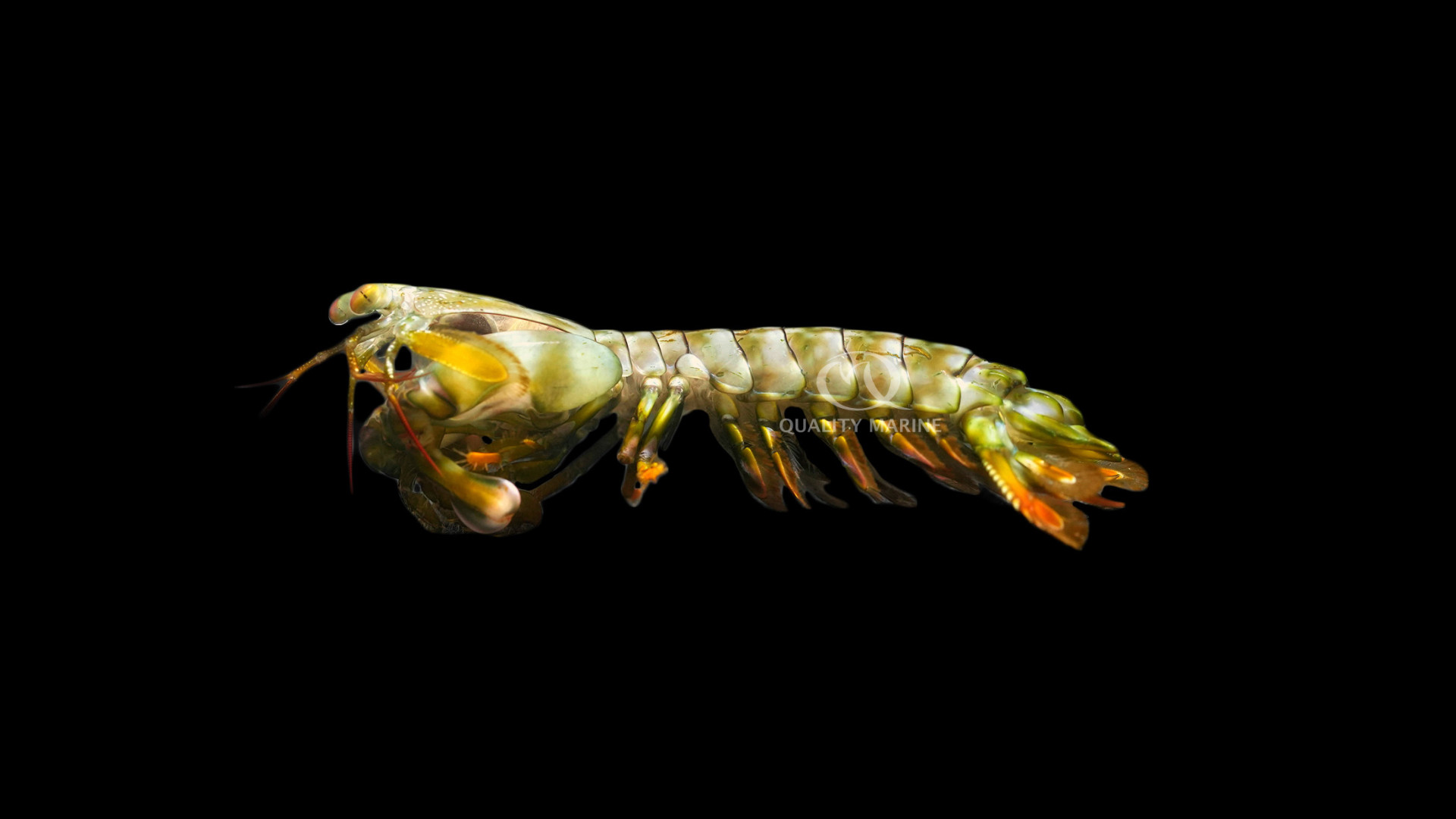The Mystery Of The Amazing Mantis

It's easy to see how the Mantis Shrimp got its name. They are similar to the terrestrial praying mantis in both appearance and appetite. From there, the “Shrimp” part of their name is a little harder to see. They are much larger than any of the ornamental shrimp we usually see in aquariums, and they are also much more likely to eat everything else in your aquarium! The Mantis Shrimp has an appendage called a “raptorial claw” and these can be used for clubbing open shelled invertebrates like clams and snails or used for spearing fish. While this is an amazing species to keep as a wet pet, this adaptation (among others) means they should always be kept as a species-specific display (meaning they should be the only thing in the display that is not substrate, rock, or food for the Mantis!)
The Colored Mantis Shrimp (Lysiosquilla sp) are spearers, adept nocturnal hunters and daytime ambush predators. Their raptorial claw can move at speeds exceeding 50mph, impaling their prey on the serrated blade of an appendage. The shrimp will hide in its burrow and wait for an unsuspecting fish or invertebrate to swim past and it will move so quickly that you'll barely see it. This is an amazing phenomenon to watch in the home aquarium (or anywhere actually).
Here at Quality Marine, we feed our spearers a variety of thawed marine based foods, like silversides, market fish and shrimp. Very small Mantis Shrimp will usually accept krill, feeder fish and shrimp. Adults generally need to be fed a moving target when initially introduced to the aquarium; to this end, we use feeder sticks, and suggest you do the same. The spearing mechanism of their predation is so fast that your likelihood of injury is high if you get anywhere near their target. Getting speared or clubbed by a shrimp can be a serious injury. Don't risk this. If you have a culture of sterile feeder fish like marine raised platies or guppies, your Mantis Shrimp will love these, and it would be quite a display.
Colored Mantis Shrimp will get somewhere between eight and twelve inches long at adulthood. That being said, they don't need a huge amount of space as long as they are well fed. A 40 to 50 gallon, long or cube aquarium is plenty. Make sure the rockwork is very stable as Lysiosquilla are adept burrowers and will quickly undermine and tumble rocks that are propped on sand or not firmly affixed in place. This rockwork should be planned with several burrows and hiding places set up for you to be able to see into them. The shrimp will add more, but it makes for a great display if you can usually have a glimpse of your “hiding” Mantis. Give them plenty of rocks and swim paths to move around and hunt. You will want a tight-fitting lid and strong filtration as they are messy eaters.
In regard to lighting, most Colored Mantis Shrimp will have some markings that will look cool under actinic lighting but avoid overly intense light. LED night lights are also a nice touch as many shrimp will be active at night. All Mantis Shrimp have incredible “eyesight”. Their visual acuity may be the best in all of the animal kingdom. Their eyes contain photoreceptors for 12 wavelengths including some polarized, UV and infrared spectrums. In comparison, human eyes see 3 wavelengths. Mantis Shrimp eyes can be independently positioned for stabilization in at least 3 planes (pitch, yaw, roll). AMAZING. Needless to say, they don't need, and won't appreciate dazzlingly bright reef lights. Lysiosquilla are among a very small number of invertebrates who can use both this amazing eyesight, and a powerful sense of smell to identify other animals; they can identify prey, predators and other shrimps that they have encountered in the past.
As of writing, no one is commercially spawning Mantis Shrimps of any genus. While most species are sexually dimorphic (males and females look different), these differences can be very subtle to the untrained eye. Even when males and females can be identified, the Shrimp are difficult to pair unless caught as such. Most species are thought to be both socially and sexually monogamous, and some species mate for life. Females will carry and care for eggs which are cemented together with a secretion from the female. After the eggs hatch, the larvae will go through several stages before they look like adult Mantis Shrimps. These larvae are pelagic, and often times also cannibalistic; both of these traits are serious challenges to overcome in captive breeding.
As previously referenced, some Mantis Shrimps are “Smashers” eating mostly shelled invertebrates like gastropods and mollusks, which they smash open. These Shrimp can move even faster than spearers, delivering a force that is near 1500 newtons. As a comparison, in order to pick up an offensive lineman in the National Football League, you'd need about this same amount of force. This smash can sound like the crack from a small gun or firecracker in the distance. With good reason, the club claw is moving almost at bullet speed. Fishkeeping forums are littered with tales (many true) of Mantis Shrimps breaking glass aquariums, and it is these Smashers that should take the blame for this. If you are unsure about the species of Mantis you're getting, always default to a nice thick acrylic tank.
Lysiosquilla are wet pets with amazing personalities (shrimp-alities?) that can learn to recognize their aquarist. They are endlessly fascinating to watch and if there was ever a species worth keeping a species-specific aquarium, Colored Mantis Shrimp would be that thing. They are not difficult to keep and can live for a few years. If you're looking to try keeping a Mantis for yourself, head to your Local Fish Store and ask for a sustainably harvested specimen from Quality Marine.